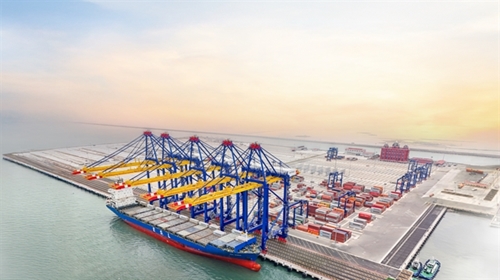Equipped with cutting-edge technology at berths 5 and 6, HHIT marks Vietnam's first privately developed smart port. The terminal boasts automated entry and exit gates, semi-automated berths, and the capability to accommodate the world’s largest container ships, including vessels sailing directly from the US West and East Coasts.
    |
 |
|
An overview of the Hateco Hai Phong International Container Terminal (HHIT) at the Lach Huyen deep-water port in Hai Phong City. (Photo courtesy of the firm) |
The new Hateco Hai Phong International Container Terminal (HHIT) spans 73ha, featuring a 900m wharf with a water depth ranging from -16.8 to -18.4m. The terminal can accommodate two ultra-large container vessels simultaneously, each up to 200,000 DWT (over 18,000 TEU) and 400m in length. The launch of HHIT represents a significant milestone in Vietnam’s maritime development, boosting international trade and driving economic growth not only in the northern region but across the nation.
Technologically advanced, the port is equipped with 10 STS shore cranes, 36 electric e-RTG cranes, and 1,350 refrigerated container sockets, ensuring efficient and high-speed loading and unloading while conserving energy and minimizing environmental impact. A smart operating system underpins its operations, with the Terminal Operating System (TOS) synchronizing all processes, a real-time Operations Centre (OC) monitoring activities, and advanced technologies such as QR scanning, OCR, and smart security systems further optimizing performance.
Notably, HHIT is the first port in the country to implement the TAS (Truck Appointment System), enabling container truck drivers to schedule pickups in advance, saving time and improving overall operational efficiency.
At the inauguration, Danish Ambassador to Vietnam Nicolai Prytz said: “This terminal represents far more than just an infrastructure project. It is a powerful example of a formidable innovative partnership in the endeavor to build an extremely efficient operational port. However, it is also a significant contribution to Vietnam’s goal when it comes to the green transition, given the ambitious focus on sustainability, through its state-of-the-art green technologies, automated systems and steadfast commitment to the environment and emission reduction.”
Nguyen Duc Tho, Vice Chairman of the Hai Phong municipal People’s Committee, announced that cargo throughput in Hai Phong has been consistently growing by 12–15% annually, reaching 190 million tons in 2024 and projected to hit 212 million tons in 2025.
The Lach Huyen port area is undergoing development to become a major international gateway and transit hub. Planned facilities will accommodate containers, general cargo, bulk goods, liquid and gas shipments, passenger services, and public maritime operations. The port is designed to handle container vessels of up to 18,000 TEU, general and bulk cargo ships of up to 100,000 tons, liquid and gas tankers of up to 150,000 tons, and cruise ships of up to 225,000 GT.
Robert Uggla, Chairman of A.P. Moller-Maersk, the parent company of APM Terminals - Hateco’s strategic partner in developing the HHIT said: “Vietnam is rising as a manufacturing and trade powerhouse, and Hai Phong sits at the heart of this growth. Through our involvement here, we’re not just building infrastructure - we’re enabling businesses, creating jobs, and connecting Vietnam to the world,” he added.
At the ceremony, Hateco Group also signed a memorandum of understanding with APM Terminals to establish a strategic partnership in Vietnam’s port and logistics sector. Under the agreement, the two parties will strengthen co-operation in two key areas.
First, in port development and operations, they will work together on infrastructure projects - covering investment, design, and operational efficiency - to enhance Vietnam’s port capacity.
Second, in the logistics sector, efforts will be closely integrated with port operations to improve connectivity between ports, logistics centers, and inland transport. This aims to deliver seamless supply chain solutions and leverage synergies from existing port activities.
Source: VNA